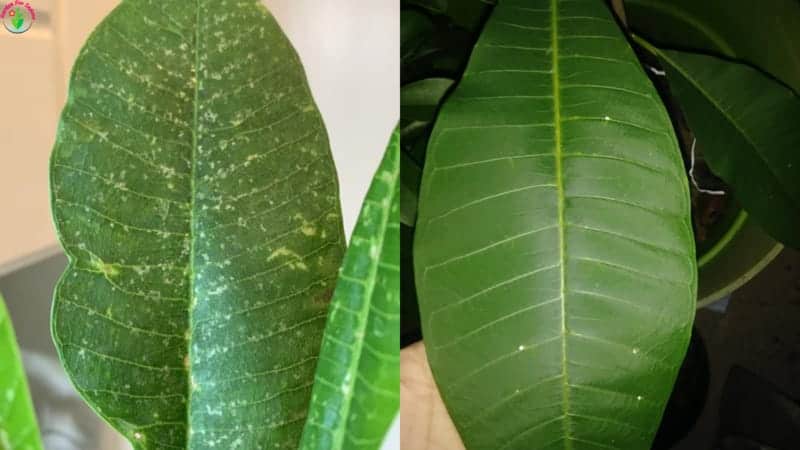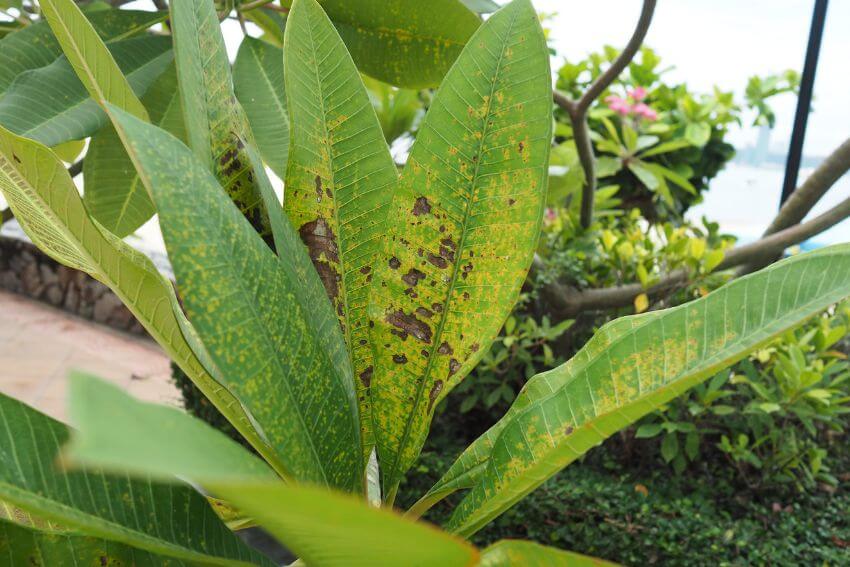Plumeria, also known as Frangipani, is a popular tropical plant renowned for its stunning flowers and pleasant fragrance. However, Plumeria plants can sometimes develop issues, one of the most common being leaf spots. These spots can be an indication of various underlying problems, from environmental stress to pest infestations or diseases. In this post, we will explore the causes, types, treatment, and prevention of Plumeria leaf spots, providing you with an exhaustive guide to maintain your Plumeria’s health and beauty.
What Are Plumeria Leaf Spots?
Leaf spots are discolored areas on the leaves of plants. On Plumeria, these can appear as small dots or larger patches and can be various colors, including yellow, brown, or black. These spots are not only unsightly but can also hinder the plant’s overall health and growth.
Common Causes of Leaf Spots on Plumeria

Understanding what causes leaf spots is vital for treating and preventing them. Here are some common culprits:
1. Fungal Infections
Fungal infections are a prevalent cause of leaf spots in Plumeria. Various fungi can attack the leaves, leading to discoloration and eventual leaf drop.
2. Bacterial Diseases
Bacterial infections can also lead to the development of leaf spots. These spots often appear water-soaked and may have a dark border.
3. Environmental Stress
Environmental factors such as excessive humidity, poor air circulation, or direct scorching sun can stress Plumeria plants, resulting in leaf spots.
4. Nutrient Deficiencies
A lack of essential nutrients, particularly nitrogen, potassium, and magnesium, can manifest as leaf spots and discoloration.
5. Pests
Pests such as aphids, spider mites, and thrips can lead to leaf spots as they damage the plant tissue while feeding.
Types of Leaf Spots on Plumeria
Identifying the type of leaf spot can help in diagnosing the underlying issue. Here are some common types of leaf spots found on Plumeria:
| Type of Leaf Spot | Appearance | Possible Cause |
|---|---|---|
| Brown Leaf Spots | Small, dark brown or black spots | Fungal infections |
| Yellow Leaf Spots | Irregular yellow patches | Nutrient deficiencies or bacterial infections |
| Water-soaked Leaf Spots | Dark, moist-looking spots | Bacterial diseases |
| Wilting Leaf Spots | Droopy leaves with spots | Environmental stress or pest infestation |
Diagnosing Plumeria Leaf Spots
Diagnosis is key to treating Plumeria leaf spots effectively. Here are steps you can follow:
1. Visual Inspection
Check the leaves closely for patterns in the spots, which can give you clues about the cause. Different diseases exhibit different characteristics.
2. Consider Environmental Factors
Evaluate the growing conditions of your Plumeria. Are they receiving adequate light? Is the humidity too high? 🌦️
3. Test Soil Nutrients
Conduct a soil test to check for nutrient deficiencies that could be contributing to the leaf spots.
4. Look for Pests
Inspect the underside of leaves and around the stems for any signs of pests like aphids or spider mites.
Treating Plumeria Leaf Spots

Once you have identified the cause, treatment becomes easier. Here are some common treatments based on the identified problem:
1. Fungal Infections
To treat fungal infections, consider using fungicides specifically formulated for plants. Ensure good air circulation around the plant to prevent further infection. 🌿
2. Bacterial Diseases
For bacterial leaf spots, remove the affected leaves and apply a bactericide. Ensure that you are watering the plant in the morning to avoid prolonged leaf wetness.
3. Environmental Adjustments
If environmental stress is the cause, consider relocating your Plumeria to a more suitable area where it can receive filtered sunlight and better airflow.
4. Nutrient Management
Fertilize your Plumeria with a balanced fertilizer to address any nutrient deficiencies. Look for fertilizers high in nitrogen, potassium, and magnesium.
5. Pest Control
If pests are the issue, use insecticidal soap or neem oil to control the population. Make sure to follow the instructions for application to avoid harming the plant. 🐞
Preventing Leaf Spots on Plumeria
Prevention is always better than cure! Here are some tips to prevent leaf spots from occurring on your Plumeria:
1. Proper Watering
Water the plant early in the day to allow leaves to dry before nightfall, reducing the chances of fungal and bacterial growth.
2. Maintain Air Circulation
Ensure that your Plumeria is not overcrowded with other plants to allow for adequate air circulation. This can prevent humidity buildup around the foliage.
3. Regular Monitoring, Plumeria Leaf Spots
Keep an eye on your plant regularly for any signs of leaf spots or pests. Early detection can make treatment much easier and more effective.
4. Balanced Fertilization
Fertilize your Plumeria regularly with a balanced fertilizer during the growing season to ensure it receives all necessary nutrients. 🍃
5. Cleanliness
Regularly remove dead leaves and debris from around the base of your Plumeria, as these can harbor diseases and pests.
Additional Tips for Healthy Plumeria
Here are a few more tips to keep your Plumeria healthy and vibrant:
1. Pruning
Regularly prune your Plumeria to remove any dead or affected leaves and branches, which can improve airflow and reduce the risk of disease.
2. Proper Potting
Ensure your Plumeria is in a well-draining pot and soil mix. This helps prevent waterlogging, which can lead to root rot and subsequent leaf spots.
3. Seasonal Care
During the winter months, when Plumeria may enter dormancy, reduce watering and stop fertilizing until new growth appears in spring.
Note: Always use clean tools when pruning or treating your Plumeria to prevent the spread of diseases.
Final Thoughts
Dealing with leaf spots on your Plumeria can be frustrating, but with proper knowledge and care, you can manage and prevent these issues effectively. Regular monitoring and attention to environmental conditions are key to maintaining the health of your Plumeria plants. With the right approach, your Plumeria will thrive, rewarding you with its beautiful blooms and lush foliage. 🌺
